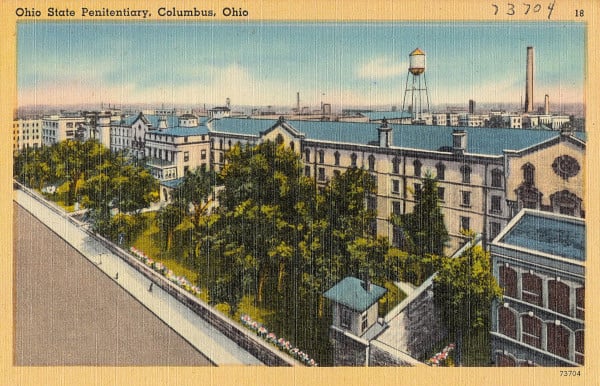New technology like tamper-resistant sprinklers and stricter fire codes keep prisons safer today
In 1930, the Ohio Penitentiary at Columbus became an inferno and hundreds of inmates died. Some were kept locked inside their cells by apathetic or sadistic guards; others were released too late to find safety.
This horrific tragedy was the perfect storm of negligence and inept fire safety practices: a building packed with too many people, guards with zero training, and no emergency protocols. Added to this stew of problems was an array of combustibles. The blaze started in a mix of newly cut scaffolding timber; it grew by feeding on an ancient wooden roof; its source of ignition was a candle on a pile of oily rags.
The magnitude of the Ohio Penitentiary fire was certainly preventable, as was the loss of life.
Today, candles found in a prison would be contraband. The rotting roof that sheltered the inmates would be fireproofed. A modern facility would mandate smoke detectors, guards trained in using onsite fire extinguishers, and there would likely be a network of sprinkler pipes called for by NFPA 101: Life Safety Code.
Read on to learn how the fire started and progressed—and how life safety in prisons changed in the aftermath of the disaster.
Looking to add fire protection to an institutional setting? QRFS carries tamper-resistant Viking and Tyco institutional sprinklers that can be ordered by calling us at 888.361.6662 or emailing support@qrfs.com. You can also browse our selection of institutional Shutguns, which quickly shut down accidental or malicious sprinkler discharges.
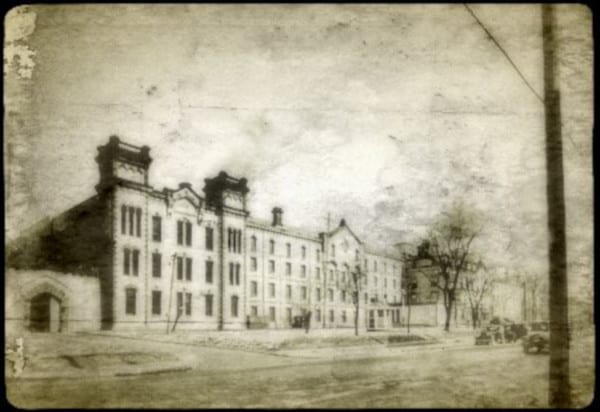
The Ohio State Penitentiary held no prizes for livability or safety—then its worst tragedy struck
The Ohio State Penitentiary was an outgrowth of the Columbus town jail that had only thirteen cells in 1815. The penitentiary officially opened in 1834 but buildings were still being constructed; by 1837, state officials had added a women’s wing. Over the decades leading up to the 1930 tragedy, the penitentiary became the site for Ohio executions by hanging and, later, the electric chair.
In 1963, the death penalty was outlawed in Ohio but the prison continued to house male and female inmates until its steel doors clanged shut permanently in 1984. All of the penitentiary buildings were razed in 1998.
During the early years of the Great Depression, the prison was a crowded, miserable destination for those convicted of both non-violent and violent crimes. At the time of the fire, its walls held 4,300 inmates in a facility designed for 1,500.
In the early evening of April 21, a slow-burning fire broke out in the western edge of the six-story West Block, where a tall, wooden scaffold had been built as part of a planned expansion. Candles ignited rags that burned the green wood of the new structure, producing a heavy black smoke that poured into a section housing 800 prisoners.
Arson is considered the most likely cause, but controversy about the fire’s origin continues. After the main fire, three smaller fires were undoubtedly intentional.
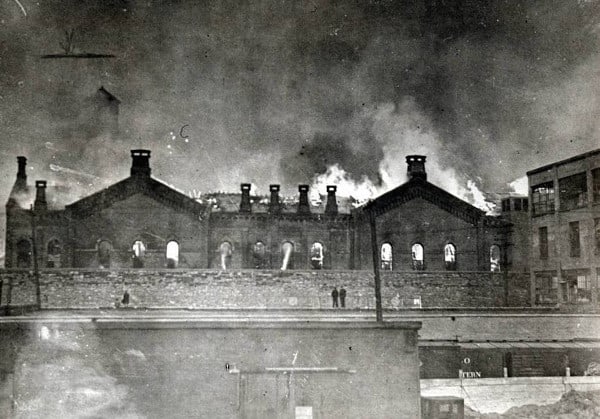
Thick smoke, desperate escapees, riots, and prisoners abandoned in their cells
It was late afternoon and the inmates had just been locked inside for the evening. As the wooden scaffolding began to burn, it created noxious smoke. Men pleaded with guards to unlock doors as the smoke filled their cells. Reports indicate that their cries were heard but ignored; in fact, guards were reported to have continued locking up inmates as part of the evening routine even after smoke appeared.
As the fire spread upward, the roof caught fire, endangering more prisoners on the upper floor. Two inmates took their chances and forced keys from a guard, and then began releasing their fellow prisoners. Before smoke reduced visibility and the flames closed in, the two men were able to free about 50 prisoners. A reported 160 inmates were trapped in either their cells or the building when the roof eventually collapsed.
Amidst the horror of locked prisoners, indifferent guards, and smoky chaos, another problem developed. Prisoners began heaving rocks at guards who were not only refusing to help them but locking them up. When firefighters arrived, they struggled through the violence to reach access points to quell the flames.
Guards stationed at prison walls and guard towers manned machine guns to prevent escapes. Prison officials recruited 500 soldiers from a local military base, Fort Hayes, who quickly arrived at the scene.
The scope of the fire also brought additional reinforcements in the form of a troop of National Guardsmen. These troops secured bayonets to their weapons as they readied themselves to “shoot to kill,” according to orders by penitentiary officials.
The prison, surrounded by men with guns, was secure while the fire roared and grew.
All of this extra security was called for before Warden Preston Thomas contacted the Columbus fire department. NFPA Journal later reported that Thomas believed the fire was part of an escape attempt, and he was determined to not let that happen.
Prisoners who survived recounted terror; many of those who died were “cooked alive”
Fire in the Big House by Michael Roth narrates the stories of men who survived the fire and describes the conditions in which bodies were found. Roth sets the scene:
The blaze flashed along oil-soaked forms and dry timbers from I&K [sections], undergoing reconstruction, southward into the ill-fated cellblocks, igniting the ancient wooden roof, which was overdue to be replaced. Clouds of smoke billowed out, filling not just the cellblocks but the prison quadrangle as well.
Inmates responded with acts of desperation as they were unable to escape their locked cells:
As the heat grew more intense, some prisoners still locked in the G&H tiers ran water in their sinks and dashed water on their faces and each other; others soaked blankets and hung them in front of their cells to keep smoke out; still others dipped their heads into their water-filled toilet bowls (some of the dead were found in this position). Several reportedly slit their own throats rather than be burned alive, while others pleaded with guards to shoot them…
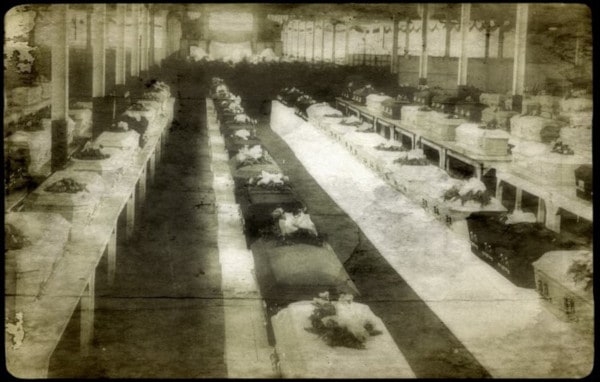
Although the majority of inmates did find safety, those in the West Unit were hard hit. Most men died there from smoke inhalation after the highly combustible materials—the scaffolding and old roof—began burning. Some prisoners were burned, unable to escape their locked cells or the building, while others trapped in metal cages were cooked by the intense heat.
On April 22, the local Zanesville Signal newspaper reported that 319 men had lost their lives. An additional 150 were hospitalized with a “slight chance of recovery” and “100 others were suffering minor injuries.”
Five more prisoners died within days of the blaze. The final body count left no room for doubt: this was one of the deadliest fires in U.S. history—and the deadliest prison fire.
Watch this video to learn more about the Ohio State Penitentiary Fire (warning: some images may be graphic):
The Ohio Penitentiary fire changed the Ohio prison system
Fire protection was not entirely lacking on the 1930 Ohio State Penitentiary campus but it was grossly inadequate for anything more than a minor fire. The measures at the time included:
- Numerous fire hydrants connecting to city water mains outside of the south and west prison walls.
- Small extinguishers within prison walls, spread throughout the campus.
The prison included a 134-foot-high water tower with a tank containing 125,000 gallons within the prison walls, but no hydrants to access the water for firefighting. Several hundred feet of 2.5-inch, cotton and rubber-lined firehose were also found on reels at the penitentiary. A fire insurance report released shortly after the fire noted that “there [was] no institutional organization” available to employ these resources.
In 1930, conditions for prison reform were ripe following a series of nationwide prison riots that began in the summer of 1929 and intensified after the Ohio disaster. At the time, it was the deadliest fire in U.S. history inside of a building, aside from the fire that tragically ravaged the Iroquois Theater in 1903. Press and community scrutiny resulted in two important reforms:
- Minimum sentencing laws were changed, as laws requiring sentences for minor crimes were considered as contributing factors to overcrowding.
- Laws passed the next year (1931) created the Ohio Parole Board, including parole procedures to release 2,346 prisoners from the facility in 1932.
These changes improved conditions for inmates, and Ohio began to address fire safety immediately. Within weeks of the tragedy, three separate investigations were launched by the state fire marshal, the Attorney General’s office, and the Ohio governor.
Under questioning by the Governor’s Inquiry Board, the warden admitted that he was more concerned with escapes than the fire itself while blaming the state for overcrowded conditions. Warden Thomas also asserted that common sense, rather than guard training, was sufficient for meeting emergency evacuation standards, according to an NFPA Journal report.
A report from the Ohio Inspection Bureau (OIB), a private organization supported by fire insurance companies, concluded that the following would have mitigated, if not prevented, much of the damage:
- Fireproof building construction
- Adequate fire division walls
- Adequate first aid equipment
- Automatic sprinklers
A January 1, 1931 local newspaper feature included in the OIB report announced that a new, fireproof roof had been installed over the penitentiary as it readied itself to receive more inmates. As of that writing, the recovering prison was described as “idle.”
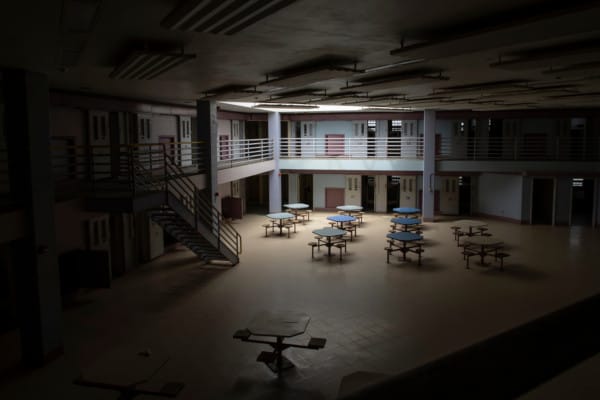
After the smoke cleared: prisons are safer from fire
Automated sprinkler systems existed in 1930 and the city of Columbus had a well-trained fire department, but the Ohio State Penitentiary personnel and building standards were inadequate. The warden was uninterested in preparing for fire or other emergencies and passed this attitude along to the guards. The building itself contained multiple weaknesses, including highly combustible materials.
While the Ohio Penitentiary was one of the worst offenders among prisons, it was hardly alone in its draconian living conditions and lack of building and fire safety codes. The loss of life there was accelerated by the timing of the fire, the priorities and delays of the warden, and environmental conditions (including wind and inmate rage) that made fighting the fire more difficult. Yet, underlying weaknesses in basic fire safety—due partly to the state of fire codes in 1930—contributed significantly to the catastrophe.
Today, the Ohio conflagration is ranked by NFPA as the thirteenth deadliest fire in U.S. history. And conditions nearly a century ago paint a stark contrast with contemporary prison fire safety standards.
In the nine decades since the fire, significant strides have been made to improve the underlying conditions in U.S. prisons, such as overcrowding and inadequate correctional officer training. The National Fire Protection Association (NFPA) and the Occupational Safety and Health Administration (OSHA) have specifically mandated improvements to custodial institutions, including correctional and detention facilities.
For example, modern prisons use fire-resistant materials, follow detailed automatic fire detection and notification requirements, and automatic sprinklers are installed in Use Conditions II through V per NFPA 101: Life Safety Code.
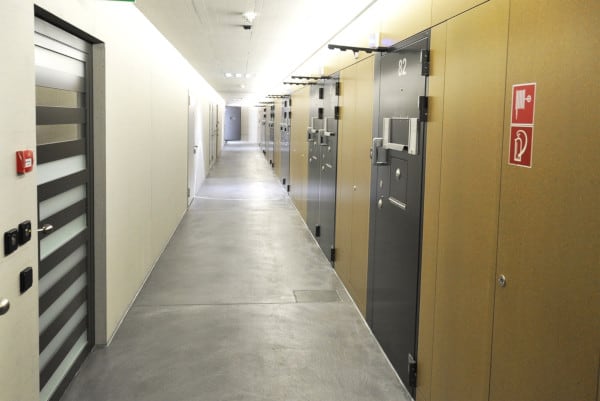
NFPA 101 changed its codes for prisons as a result of the Ohio fire, specifically recommending in the tragedy’s aftermath that existing and new facilities be built with limited- or non-combustible materials. Additionally, the new code stipulated more stringent rules for the use of automatic sprinklers and/or fire alarm detection in prisons and detention facilities, both new and existing.
The most recent edition of NFPA 101 addresses prisons in “Chapter 22: New Detention and Correctional Occupancies” and “Chapter 23: Existing Detention and Correctional Occupancies.” Language in both chapters describes four basic provisions:
From the 2018 edition of NFPA 101
22.1.1.2.2 Because the safety of all occupants in detention and correctional facilities cannot be adequately ensured solely by dependence on evacuation of the building, their protection from fire shall be provided by appropriate arrangement of facilities; adequate, trained staff; and development of operating, security, and maintenance procedures composed of the following:
(1) Design, construction and compartmentation
(2) Provision for protection, alarm and extinguishment
(3) Fire prevention planning, training and drilling programs for the isolation of fire and transfer of occupants to areas of refuge, for evacuation of the building, or for protection of the occupants in place
(4) Provision of security necessary for the safety of the public and the occupants of the facility
U.S. prisons have also incorporated better training for correctional officers. Building doors can now be opened or closed remotely so that inmates can be released if fire, smoke, or heat block guards from turning a key manually. Tools for shutting off errant sprinklers, like Shutguns, can reduce the damage from sprinkler tampering and vandalism, making these automatic suppression systems more practical in a prison environment.
Some requirements are the result of revised NFPA code; others stem from legal decisions intended to ensure that inmates receive their right to a safe environment. This combination of new technology, correctional officer training, and legislation to address prison overcrowding has significantly improved safety.
Prison design takes “tamper-proof” equipment to a new level
Of course, prisons continue to have an “X factor” when it comes to fire safety because about a quarter of prison fires are intentional. When combined with the problem of maintaining smoke detectors, fire extinguishers, and sprinklers, safeguarding prison buildings and their inhabitants is a challenge.
Fires in prisons often occur because fire can be used as a weapon, either to harm or intimidate others, or cause self-harm. Inmates have used sprinklers to attach nooses for successful suicides. Sprinkler heads have created tempting opportunities due to boredom, despair, or aggression. Disassembly of sprinklers to reuse parts as weapons or tools is a common problem.
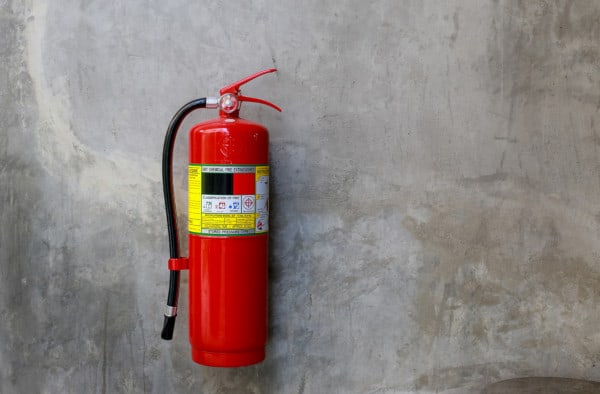
Keeping safety equipment secure requires an added layer of diligence and resourcefulness. The likelihood of inmates tampering with and sabotaging equipment in many facilities is a near certainty. For this reason, equipment specifically built for environments where sabotage could occur is now regularly installed in prisons and jails. Many structures use institutional sprinkler systems (see our blog on prison fire sprinklers), and/or minimize the use of sprinklers in housing units where rates of self-injury are higher.
To deter tampering, institutional sprinklers in prisons and mental health facilities use tamper-resistant components such as locking escutcheons and parts that will detach with added weight (typically more than 50 pounds). These parts are flush-mounted to walls, so they cannot be used as effective anchors for hanging.
Institutional Shutguns, tools, and kits are designed to quickly shut off spraying water when a sprinkler is activated but no fire is present. These devices have a fusible link thermal element that activates at 164°F (73°C) to serve as a temporary sprinkler until a replacement can be installed.

After the Ohio Penitentiary fire: modern prisons still require fire safety vigilance
The lessons from Ohio are still with us. Prison environments face unique challenges in crowd control and safety equipment maintenance. But adapted fire codes, prison reforms, and the availability of equipment that can not only be installed in prisons but effectively maintained improve the odds of preventing and suppressing fires.
If you need fire protection equipment for an institutional setting, QRFS carries tamper-resistant Viking and Tyco institutional sprinklers that can be ordered by calling us at 888.361.6662 or emailing support@qrfs.com. You can also browse our selection of institutional Shutguns and full Shutgun kits, which quickly stop accidental sprinkler discharges.
This blog was originally posted at blog.qrfs.com. Check us out at Facebook.com/QuickResponseFireSupply or on Twitter @QuickResponseFS.


